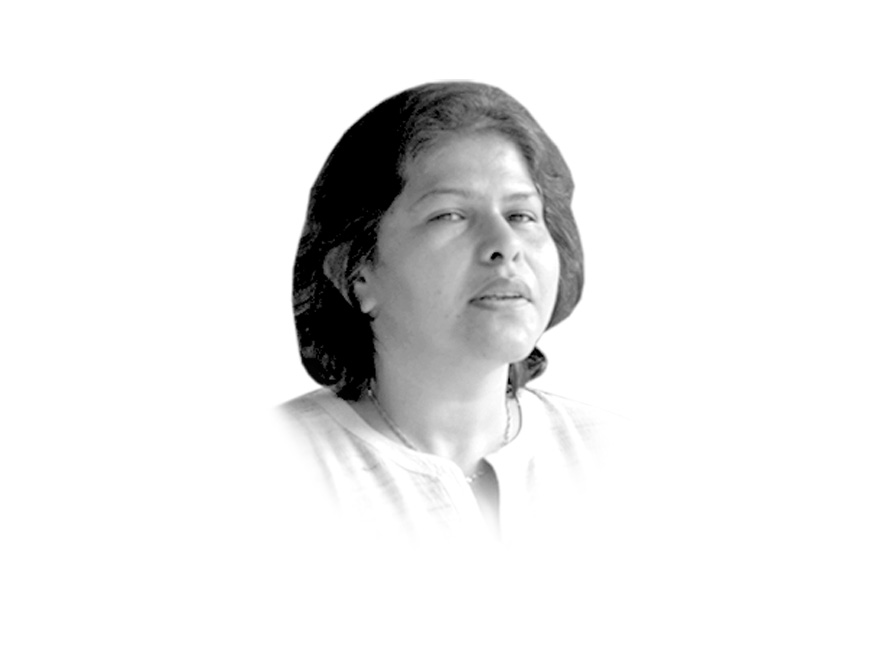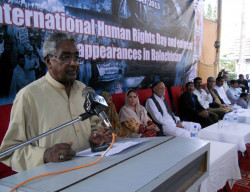
The long march of the Voice for Baloch Missing Person does not seem to attract a lot of attention. Barring a few reports, the mainstream media has not bothered to cover the journey of some Baloch people (both men and women) from Quetta to Karachi to lament, protest and draw attention towards the disappearance of their loved ones. People will probably say that this lack of attention is because the march started with just 20 people and there isn’t much hope of the numbers ballooning into hundreds if not thousands. Lalla Qadir Baloch’s roadshow will never match commercial long marches like Tahirul Qadri’s or the Difa-e-Pakistan Council; however, the key reason why these people will not get any attention is due to the state’s narrative of silence on the issue of the missing Baloch. Even the independent judiciary of Pakistan did not eventually come to the rescue of these people. And now the best way to silence these people is to ignore the issue and pretend as if it does not exist.
Silence is a great tool as it pushes an issue under the carpet, at least, up until the popular narrative can be changed through deception. Lalla Qadir Baloch is a man of the soil who cannot afford a bulletproof vehicle or a bunker. This is a man who has decided to walk approximately 700km with blistered feet that hurt and impair his pace. But no need to mention these details because he will probably be portrayed a few years later at an opportune time in glowing colours as some enemy agent.
There is nothing new in this approach as this was adopted before in case of the former East Pakistan. For over three decades, we in Pakistan were confronted with silence on the issue except some sketchy details on the dismemberment being an Indian conspiracy. While sheaves of paper were used for describing the events of 1947, very little was written on the tragedy of 1971. Even if we were to imagine that the event was nothing more than an enemy’s doing, there were no details about what happened then. We have begun to elaborate 1971 in the past decade or so when we have either constructed or found narratives which can detract people from the reality. There was much excitement about Sarmila Bose’s work when it started to surface around 2005. The final publication of the book and its circulation is welcomed. For those who think that powerful elements of the state have nothing to do with the book’s circulation must remember books that are artificially suppressed. There is even a latest technique through which you can suppress publications that are otherwise available in the market by curbing their discussion so that these do not get attention in this society where book reading is not a popular activity.
After the Bose book, others are being assisted to produce other stories such as those on violence during 1971 against other ethnicities. A couple of years ago, an Indian Bihari was a welcome guest in Islamabad documenting atrocities of the Mukti Bahini against the Bihari population. It is important to note that these stories are not a lie either. The 1971 crisis was a civil war in which various communities and thousands of people were killed and tortured. The Mukti Bahini was trained by India’s then newly established RAW as is even admitted by the organisation’s one-time head B Raman in his biography. Such partnership was almost certain in a situation where the state was callously unwilling to give a sympathetic ear to its own people. In fact, it is tragic that the same state is unwilling even after almost four decades to own those people fought against it as its own. The explanation given in defence of Jamaat-e-Islami’s Abdul Quader Molla is that he fought an enemy to protect the state. The popular narrative in today’s Pakistan does not highlight the fact that the state was then engaged in a battle against its own people, making way for an opportunity that others would exploit.
I remember my long visit to Bangladesh in 2006 for research. I had landed in Dhaka shuddering at the thought of the reaction I would get on introducing myself as a Pakistani. I remember being pleasantly surprised as there wasn’t that imagined hostility which was confined mostly to Awami League supporters or those with memories of 1971.
The emphasis of the new narrative on 1971 and present-day Balochistan tends to wrap its audience’s attention in the game of numbers. So, if you can prove that there was discrepancy in the number of people killed and women raped, the state can argue that the entire crisis was a pack of lies. Theoretically, victims of state oppression tend to exaggerate numbers to draw attention towards their misery. There is also a tendency to react against those seen as partnering with the state because these are easier to fight. There is no moral justification for such violence but then those who justify everything that the state does from the lens of realpolitik must understand such extreme reactions too. More important, there is a need to understand that such a spate of violence happens when the state abandons its people.
The story of the lost souls of 1971 and Lalla Qadir Baloch can be retold in another way but its reality remains the same: it’s the heartlessness of the state that creates enemies out of its own people.
Published in The Express Tribune, January 16th, 2014.
Like Opinion & Editorial on Facebook, follow @ETOpEd on Twitter to receive all updates on all our daily pieces.
COMMENTS (17)
Comments are moderated and generally will be posted if they are on-topic and not abusive.
For more information, please see our Comments FAQ





















1701091268-0/Elon-Musk-(3)1701091268-0-270x192.webp)






















we will fight till the last drop of our blood, till the last son of motherland. We will fight and Inshaa Allah we will gain our country back. The world will see a rising Free Balochistan.
I think the narrative presented here is flawed, if not deceptive.
Hamid Mir, host of a prime time talk show on Pakistan's #1 news channel, had an entire episode dedicated to the VBMP. The episode aired on 9 December 2013.
I've seen the VBMP covered almost daily in the print and TV media, despite the fact that there have been around a dozen people taking part in the march.
The Supreme Court also ordered the IG FC to produce missing persons and come before the court.
That has not stopped the establishment's use of kill-and-dump in Balochistan. What is happening there is truly ugly and I applaud those who speak out against the army and FC's crimes.
But there has also been silence about the Punjabis killed in Balochistan and pushed out of the province. We see news reports that give the numbers of the Baloch missing persons. No one has bothered to count the dead Punjabis. Tell me, what did these innocent laborers and civilians do to deserve being killed?
Hope you publish this comment and do not censor me!
"it’s the heartlessness of the state that creates enemies out of its own people". How true. Thank you for bringing the nation's attention to the Baluchistan people and to the Bangladesh atrocities. I recall when Ambassador Sultan Khan telling me privately that East Pakistanis were our brothers and sisters too. We had invited the good ambassador to speak at Kansas State University Manhattan,Kansas after 1971 war.
In contrary to Balochistan’s geo-strategic and geo-economic idiosyncrasy, the province has been witnessing utter neglect at the hands of successive governments — federal as well as provincial — catering among the Balochs, a deep sense of deprivation, ever-increasing frustration and unending alienation. Short shrifts given to Balochistan by self-centered rulers is beyond doubts and the province — despite rendering matchless gifts to the national economy — is marked with pathetic situation of Health, Education, other socio-economic sectors coupled with corroded law and order situation.
to read further click:http://weeklypulse.org/details.aspx?contentID=4374&storylist=2
@Shamima: If the Baloch want to work within the framework of united Pakistan, then fine. If they persist in dreams of independence, then I as a Pakistani cannot support their demands or sympathise. “
What about you thinking as a human being or as a muslim?
@Shamima wrote "If the Baloch want to work within the framework of united Pakistan, then fine. If they persist in dreams of independence, then I as a Pakistani cannot support their demands or sympathise. "
Shamima, does 'united' Pakistan consider Baluchis 1st class citizens with equal rights? If that was true, we would not be having this debate.
this is a balanced and truly grest prsce of writing
Good analysis. Case in point. States are mostly heartless bearing few exceptions. Its the people that has to stand up. History is full of such examples. As far as judiciary and police or for that matter Army concerned, well they should be professional and not politically oriented. Whether we like it or not self respected nations always demand and stand up for their rights in an well respected manner. Scotland is an example. We are prime example of slavery. We never want to come out of it. I will never support what is happening to Baloch people. But is independence and insurgency is the answer to every injustice? That's what we should ponder upon.